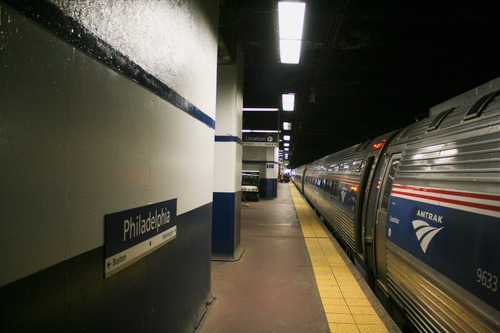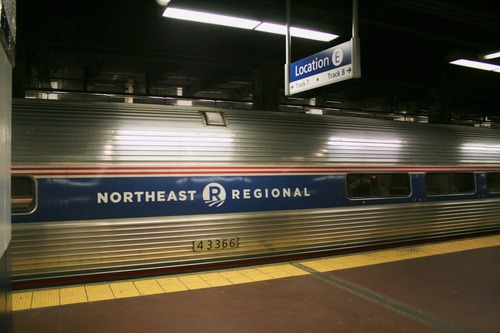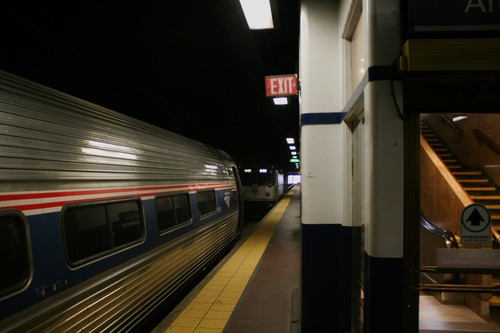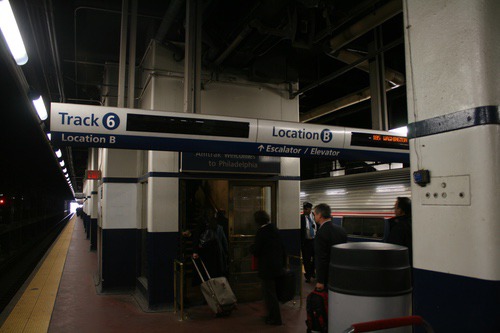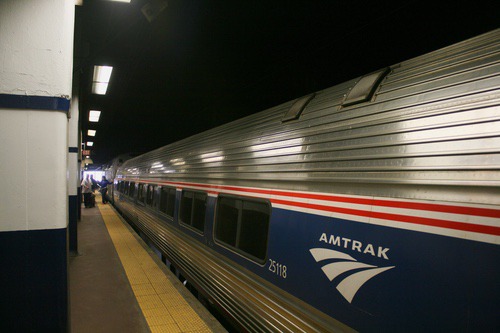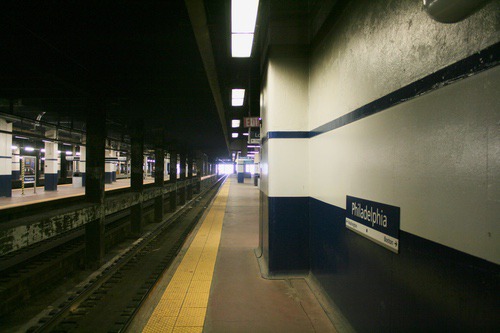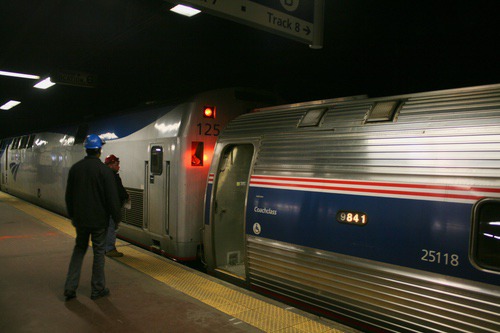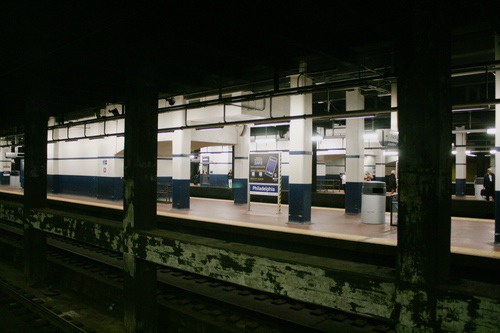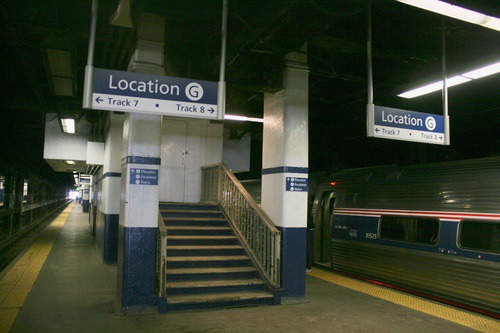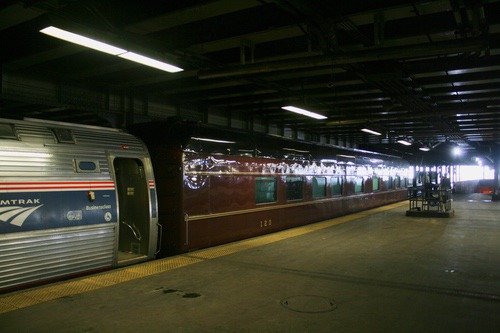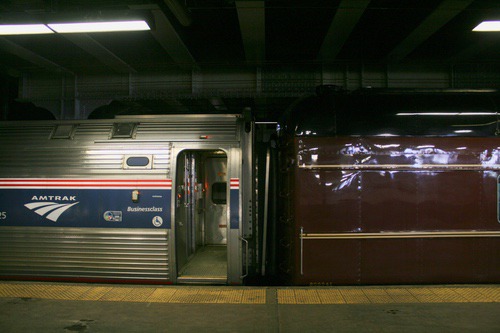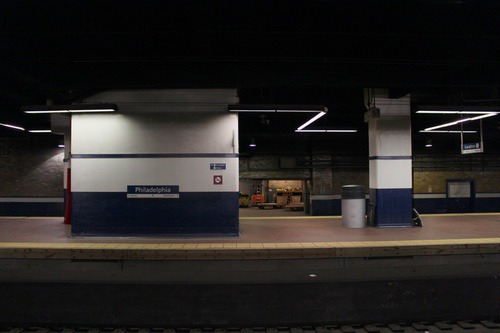


 Ardmore, PA Ardmore, PA | Keystone Service | North Philadelphia, NJ  |
 Paoli, PA Paoli, PA | Pennsylvanian | Trenton, NJ  |
 Wilmington, DE Wilmington, DE | Northeast Regional | |
| Vermonter | ||
| Carolinian | ||
| Crescent | ||
| Palmetto | ||
| Silver Meteor | ||
| Cardinal | ||
| Acela Express | Metropark, NJ  |
The Philadelphia-30 Street Station's low-level nearly underground platforms along the Schuylkill River are used by all Amtrak Intercity trains and as the terminus of New Jersey Transit Atlantic City Line trains. Northeast Regional, Acela Express, the long-distance Cardinal, Silver Meteor, Palmetto, Crescent, and state-supported Carolinian and Vermonter all just briefly stop in Philadelphia with passengers allowed through the gates by ushers (passengers had to show tickets to the usher to access the platforms until about 2015) before trains arrive in the station (like most intermediate stops on the Amtrak system except New York Penn Station or Washington, DC). A few Washington to New York Metroliner and later Acela Express Super Expresses have bypassed the station over the years but these have always come and gone with Philadelphia the third busiest Amtrak station in the country after New York and Washington, DC.
The geography of the tracks into and out of Philadelphia means the Keystone Service trains and Pennsylvanian must change direction in the station with trains scheduled for longer layovers. This includes an engine change on the Pennsylvanian which operates underwire to Harrisburg. The lack of push-pull equipment meaning the westbound train can simply ditch its electric locomotive at the southern end of the train at the same as the diesel locomotive is added to the northern end. The reverse happens for return trips. Keystone Service trains operate in a push-pull configuration with an ex-Metroliner Cab Car at one end and an ACS-64 Electric Locomotive at the other. This results in a train arriving, discharging its passengers, with new passengers invited to board shortly before the trains scheduled departure time after its layover.
Until 1980 all through trains from New York to Harrisburg (and Pittsburgh and Chicago) didn't stop at Philadelphia-30 Street Station at all, with trains using North Philadelphia as their station for the city and bypassing downtown via the New York-Pittsburg Subway at Zoo Junction. In 1980 these were just long-distance and middle-distance trains, with the former Silverliner Service trains — named Keystone Service trains — to and from Harrisburg running as basically regional rail trains (operated by Amtrak), stopping at the Suburban upper-level platforms (now exclusively used by SEPTA) before continuing to Suburban Station closer to Center City Philadelphia where these Amtrak trains terminated. Some Clocker trains also operated between Suburban Station and New York City until I believe the 1980s (Amtrak timetables make this unclear since these were a cross between a long-distance commuter and intercity train, with Amtrak and Penn Central in court over who should operate these trains).
In 1988 the electrical problems with the old Metroliner Equipment and the lack of serviceable electric locomotives that had been added for more reliability resulted in Amtrak deciding to use diesel power between Philadelphia and Harrisburg and Keystone service trains began to stop on the lower-level of 30th Street Station with diesel power banned from the underground Suburban Street Station. In the 1990s Keystone service trains began being extended to New York City. These Keystone service trains partially replaced the former Clocker trains, with an engine change from diesel to electric like on the Pennsylvanian today, until electric push-pull service was restored to Harrisburg in October 2006 with major electrical upgrades to line (including restoring 110 mph high speed rail service) with Keystone service trains today still having layovers at 30th Street Station but not requiring any change of locomotive power.
The legacy of some Amtrak trains previously continuing to Suburban Station means today all Amtrak customers with a ticket to and from Philadelphia can use it for a free ride on SEPTA regional rail to or from Suburban Station or Market East Station. The Amtrak QR codes on eTickets even scan at the turnstiles and faregates that SEPTA recently installed at all of these stations.
New Jersey Transit Atlantic City Line trains also terminate at these lower-level platforms station. These trains are all diesel push-pull sets with the locomotive on the Philadelphia-bound end of the train. These trains all discharge their passengers in the station before continuing south of the station (on the same platform) to allow the diesel locomotive to ventilate better before re-entering the station just before the departure of the next trip. The Atlantic City Line runs like a regional rail line rather than a peak-heavy commuter rail line with its twelve daily round-trips spread out throughout the day and never more than one train laying over in Philadelphia at a time.
All trains stop at one of 5 fairly-wide high island platforms for 11 through tracks through the station (the western-most track doesn’t platform). The platforms have a decent number of concrete pillars (nicely painted black and white) along them but overall don’t feel very dingy. Signage along the platform is in the Amtrak Northeast Corridor standard of white text on a blue background with the directions of Washington or Boston below each sign. The platforms had the Acela era train destination signs along each platform highlighting locations along each track, but as of 2024 these have been replaced with the standard Amtrak orange LED information signs that are now being slowly rolled out throughout the country.
To leave the platforms, doors lead to a combined staircase/escalator and a wide staircase up into the main art deco concourse of 30th Street station. Passenger elevators also provide connections directly to the Club Acela built into the upper level of the concourse, with an intermediate landing for ADA access on the main level. There are additional non-public baggage and ancillary elevators and staircases down to each platform from the station above.
Photos 1-4: November 16, 2012; 5 & 6: November 29, 2012; 7-14: March 27, 2013; 15-17: July 5, 2013; 18 & 19: October 2, 2013; 20-56: September 1, 2024; 57: January 17, 2025;
